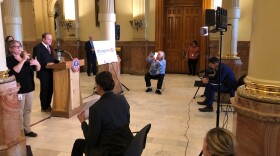As the graph below shows, the number of COVID-19 cases reported by public health agencies in the Mountain West is climbing. But what do those numbers actually say?
The short answer is, not too much.
STAT News has called the testing situation “a once-in-a-century evidence fiasco.” And as the Atlantic has written, “We know, irrefutably, one thing about the coronavirus in the United States: The number of cases reported in every chart and table is far too low.”
Testing has largely focused on people with symptoms of COVID-19 who have relevant travel histories, or contact with someone else who tested positive. In early March, the Centers for Disease Control and Prevention expanded the list of who should be prioritized for testing and state health departments have been modifying their criteria as well. But as emergency room doctors have pointed out, tests are often being “rationed” so much that even patients in the original high-priority categories aren’t necessarily being tested.
Indeed, at one of Colorado’s drive-through testing events on March 14, the Mountain West News Bureau spoke with people in a long line waiting to be tested. All had doctor’s orders, as required. Some had been trying to get tested for days already. None received tests that day.
Delays like that mean many cases continue to go undetected.
The test kits look for pieces of the virus’ RNA in people’s noses and throats, so it only works when someone is actively ill. If someone is confirmed to have COVID-19, public health officials trace who they may have come into contact with and tell them to self-quarantine. That typically doesn’t happen for the contacts of unconfirmed cases, meaning they may be spreading the disease without knowing it, and may also have difficulty obtaining a test if they do come down with symptoms.
Scientists at Fred Hutchinson Cancer Research Center and the University of Washington compared the viruses isolated from different people in the Seattle area and determined that community spread — rather than new introductions from outside the U.S. — was responsible for a big chunk of them, suggesting the focus on international travel histories was a red herring.
“The seeming sudden appearance of outbreaks across the US are not due to a sudden influx of cases,” Trevor Bedford, who is part of that research group, wrote on Twitter. “Instead, transmission chains have been percolating for 4-8 weeks now and we're just now starting to see exponential growth pick up steam.”
The other four viruses appear as one-off introductions of either immediate travel cases, or as recent steps in a newly arrived transmission chain. Given genetic proximity, these appear to be related to viruses from Europe and Iran. 4/8 pic.twitter.com/PJdzoDR8ee
— Trevor Bedford (@trvrb) March 16, 2020
Numbers are hard to come by, but according to the COVID Tracking Project, by March 16 Mountain West states had collectively tested about 3,700 people, which is about 7% of all the tests nationwide by their count.
On March 17, Science magazine reported that the U.S. has done about 74 tests per 1 million people, while South Korea has done more than 5,200 tests per 1 million people. So far, that approach appears to be reducing cases and fatalities.
According to the New York Times, “existing regulations and red tape — sometimes designed to protect privacy and health — have impeded the rapid rollout of testing nationally, while other countries ramped up much earlier and faster.”
After much delay, the Food and Drug Administration is authorizing pharmaceutical companies to make and distribute more COVID-19 test kits.
A company called Roche announced that beginning the week of March 16, each week it will ship 400,000 test kits to “more than 30 hospitals and reference laboratories in the U.S.” Another company, Thermo Fisher Scientific, said it has 1.5 million test kits ready to ship, and expects to produce up to 5 million per week in April. Additionally, the FDA said more than 40 laboratories plan to start running tests, too.
As USA Today reported, states are likely to witness a spike in case numbers as more testing becomes available.
An effort to “flatten the curve” has prompted states including those in the Mountain West to close schools and businesses. But as Stanford physician-scientist John Ioannidis pointed out, the way data is currently collected, it likely won’t show whether that’s actually being achieved.
This story was produced by the Mountain West News Bureau, a collaboration between Wyoming Public Media, Boise State Public Radio in Idaho, KUER in Salt Lake City, KUNR in Nevada, the O’Connor Center for the Rocky Mountain West in Montana, and KRCC and KUNC in Colorado. Funding for the Mountain West News Bureau is provided in part by the Corporation for Public Broadcasting.






